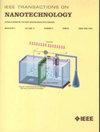Simulating Charged Defects in Silicon Dangling Bond Logic Systems to Evaluate Logic Robustness
IF 2.1
4区 工程技术
Q3 ENGINEERING, ELECTRICAL & ELECTRONIC
引用次数: 0
Abstract
Recent research interest in emerging logic systems based on quantum dots has been sparked by the experimental demonstration of nanometer-scale logic devices composed of atomically sized quantum dots made of silicon dangling bonds (SiDBs), along with the availability of SiQAD, a computer-aided design tool designed for this technology. Latest design automation frameworks have enabled the synthesis of SiDB circuits that reach the size of模拟硅悬键逻辑系统中的带电缺陷以评估逻辑稳健性
最近,基于量子点的新兴逻辑系统的研究兴趣被纳米级逻辑器件的实验演示所激发,这些器件由原子大小的量子点硅悬键(SiDBs)组成,同时还出现了专为该技术设计的计算机辅助设计工具 SiQAD。最新的设计自动化框架使 SiDB 电路的合成达到了 $\mathbf {32\times 10^{3}}\, {\mathbf{nm}}^mathbf {2}$ 的规模,比手工设计的同类电路复杂得多。然而,目前的 SiDB 仿真引擎并不考虑缺陷,而这对于这些大型系统来说是非常重要的。这项工作提出了一种将固定电荷模拟纳入已建立的基态模型的方法,以涵盖一类重要的缺陷,这些缺陷在 $\mathbf {10}\、{\mathbf{nm}}$ 或更大尺度上对附近的 SiDB 具有不可忽略的影响。通过在 SiQAD 的仿真引擎中实施该公式,并对多种类型的缺陷进行计算重现实验,验证了该公式的高准确性。新功能被应用于研究多个已建立逻辑门对引入单个附近缺陷的容差,以确定相应的最小所需间隙。这些研究结果与现有指标进行了比较,为逻辑鲁棒性研究奠定了基础。
本文章由计算机程序翻译,如有差异,请以英文原文为准。
求助全文
约1分钟内获得全文
求助全文
来源期刊

IEEE Transactions on Nanotechnology
工程技术-材料科学:综合
CiteScore
4.80
自引率
8.30%
发文量
74
审稿时长
8.3 months
期刊介绍:
The IEEE Transactions on Nanotechnology is devoted to the publication of manuscripts of archival value in the general area of nanotechnology, which is rapidly emerging as one of the fastest growing and most promising new technological developments for the next generation and beyond.
 求助内容:
求助内容: 应助结果提醒方式:
应助结果提醒方式:


